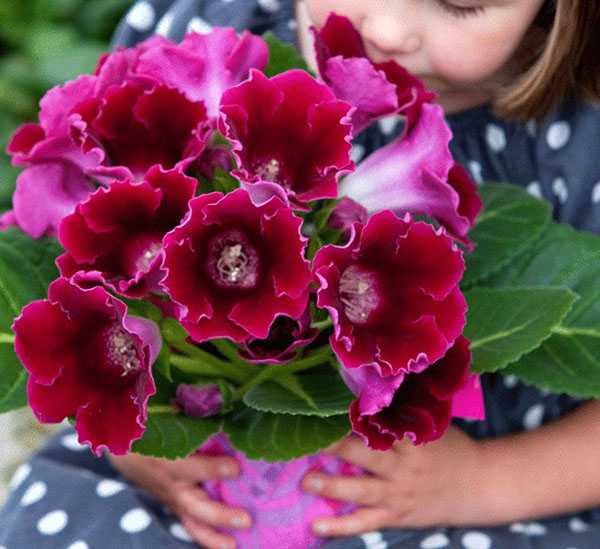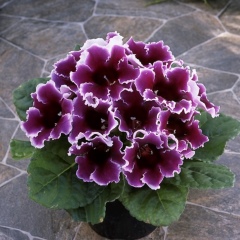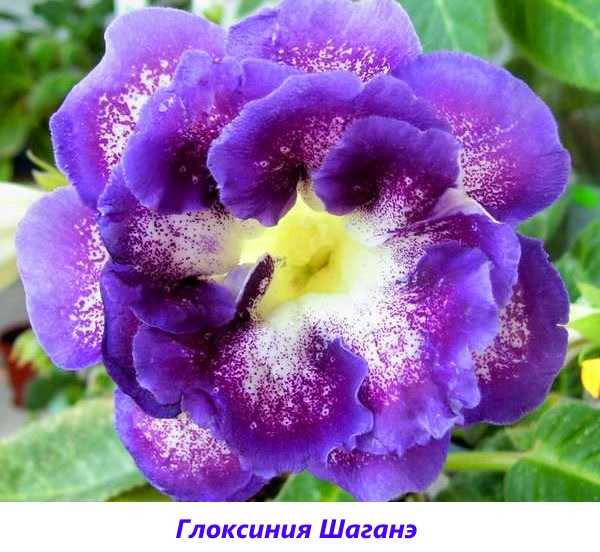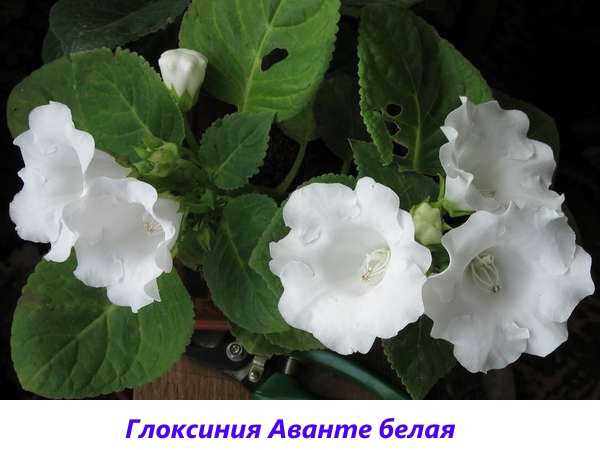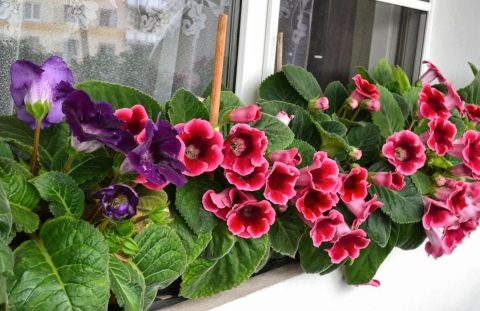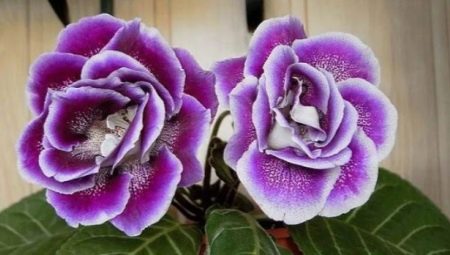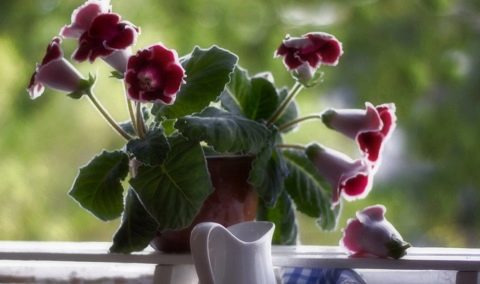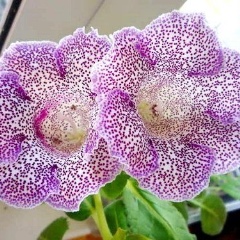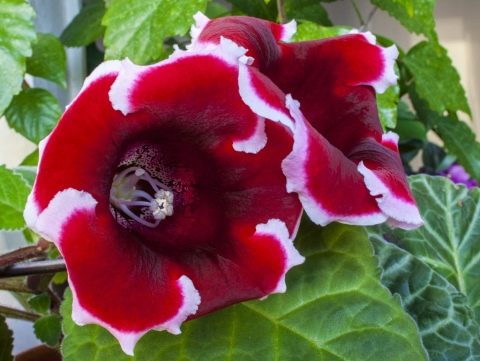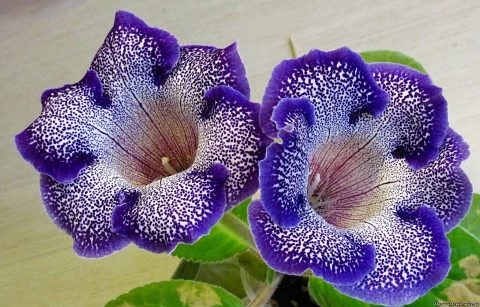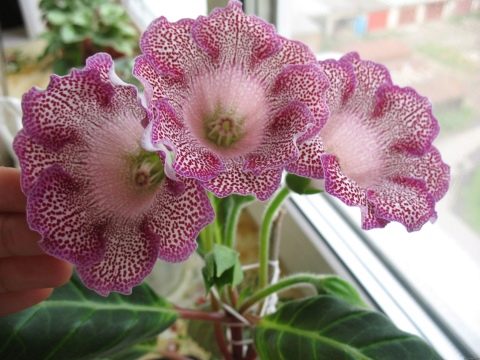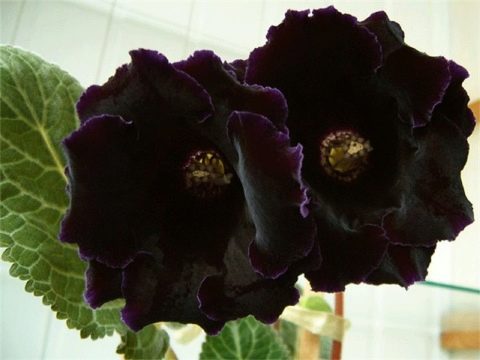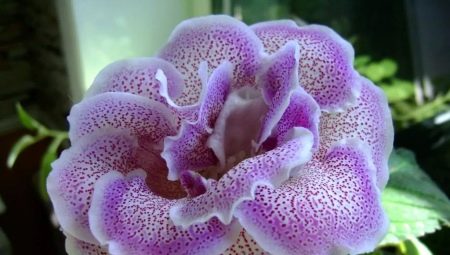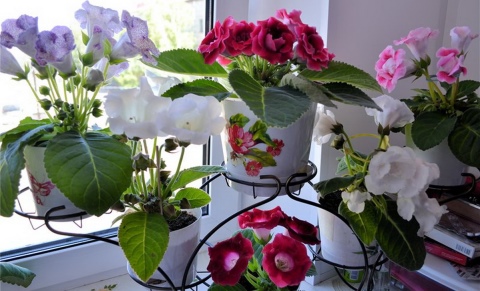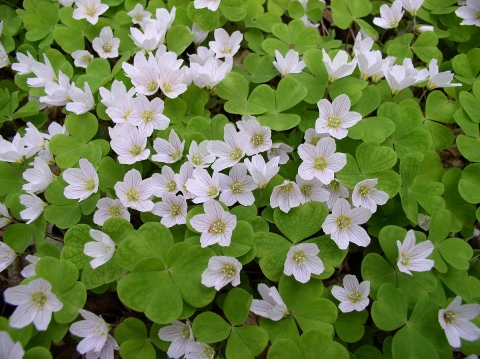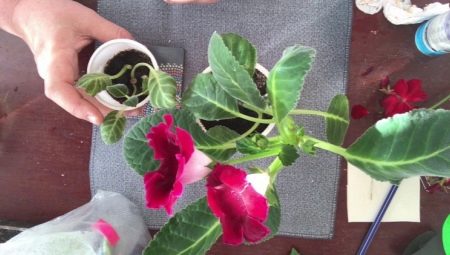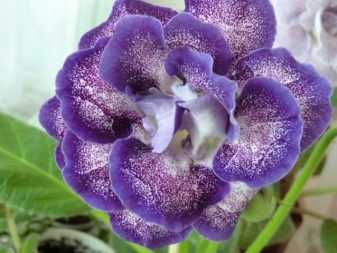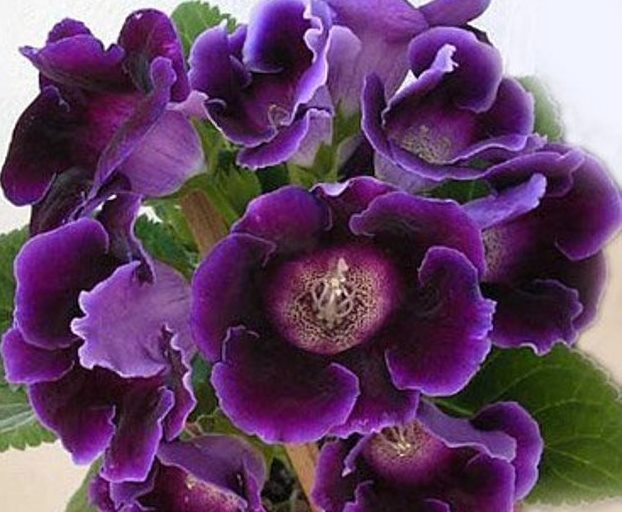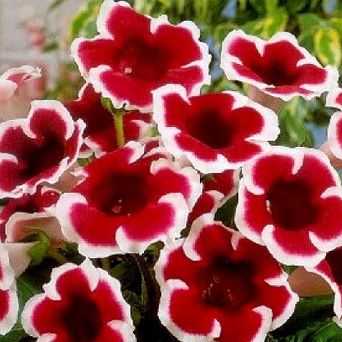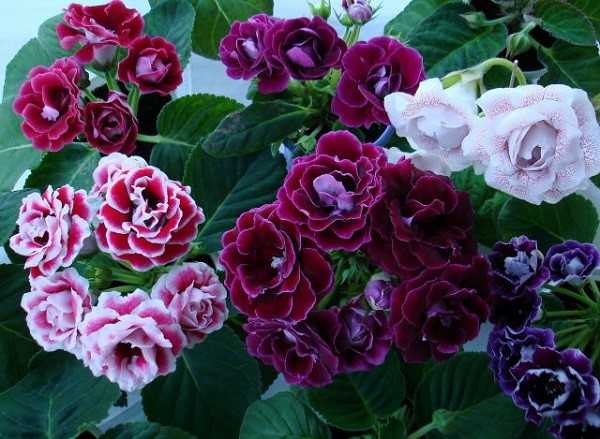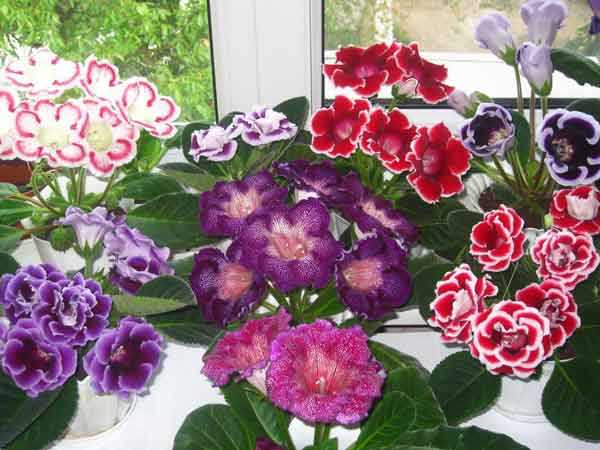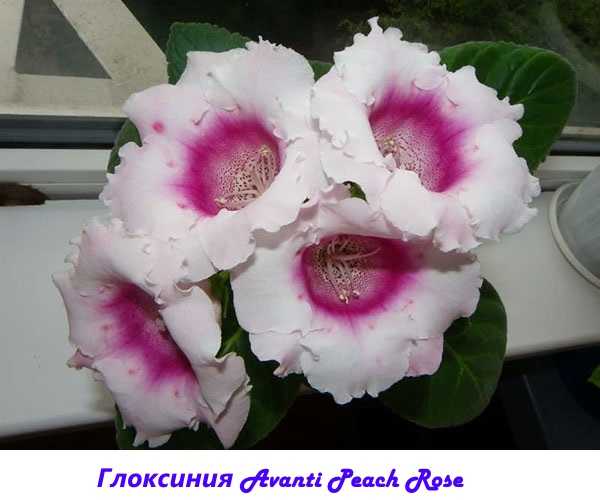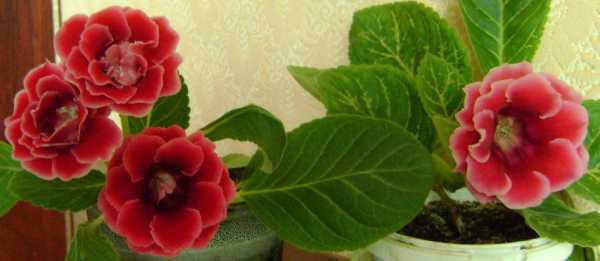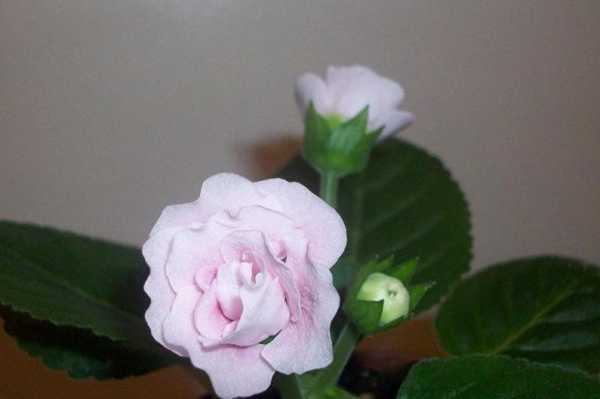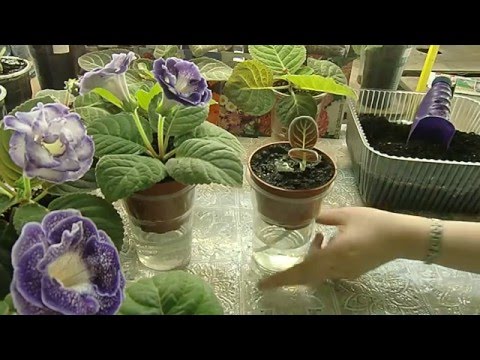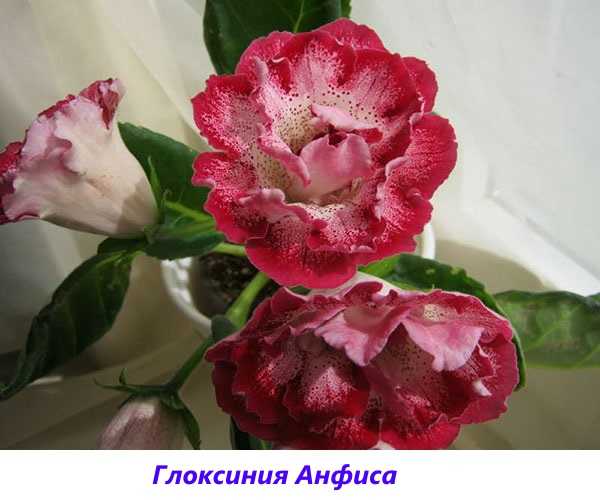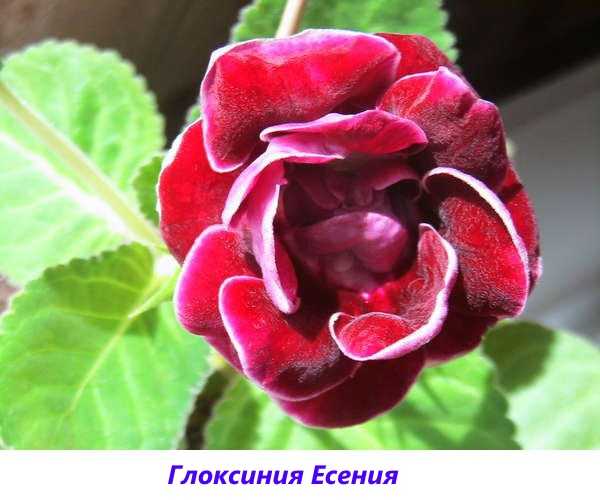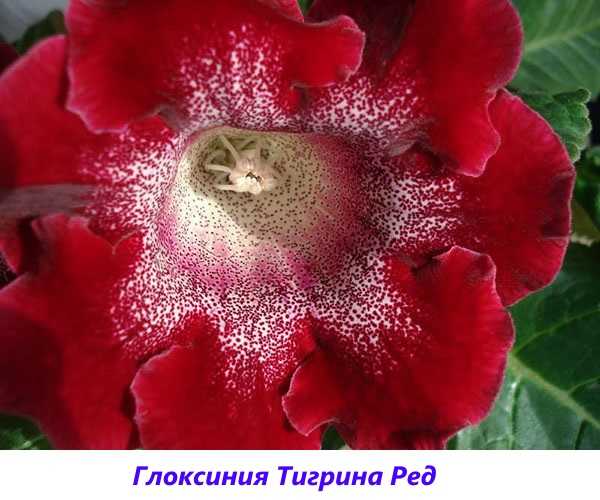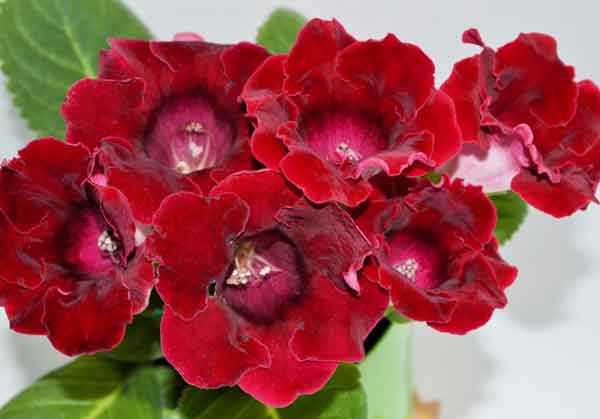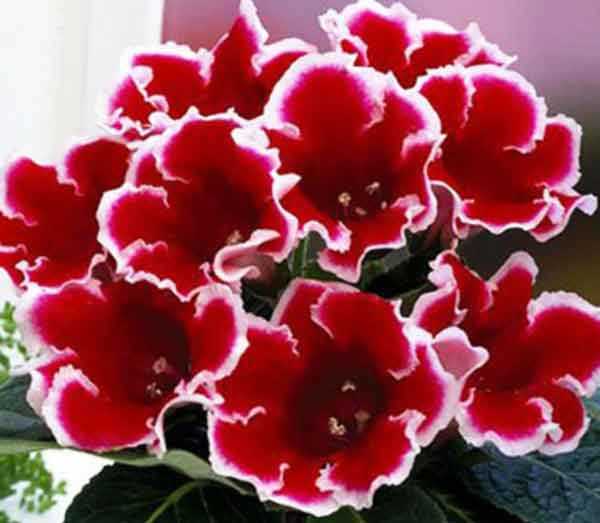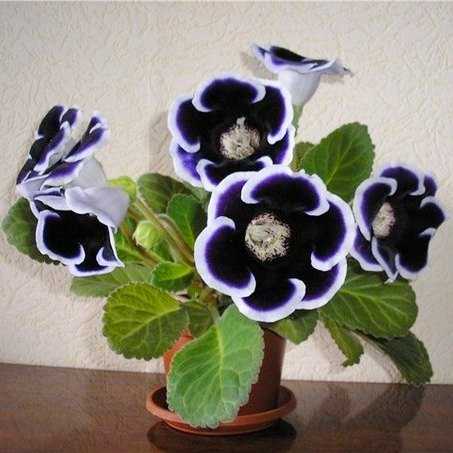Gloxinia cultivar classification
Depending on the size of the aboveground part of the plant and the rosette formed, hybrid gloxinia are divided into miniatures that do not grow more than 20 cm, and standard plants, the diameter of the leaf rosette of which can exceed 30 cm.There are also a number of varieties that occupy an intermediate position in this classification.
On this topic:
BACK
FORWARD
1 out of 5
Corollas of modern plants can consist of one or more rows of petals. Terry gloxinia are incredibly popular, because their bell-shaped flowers are more luxuriant than simple ones, and in shape they most of all resemble a camellia or a garden rose.
According to the type of color, gloxinia of modern varieties are divided into monochromatic, chintz and tigrins.
- Monochromatic flowers are evenly colored in different tones from white, light pink or lilac to purple and deep purple. Only a spot in the depth of the neck can be lighter or whiter.
- Corollas with a calico type of color are covered with uniform spots or specks.
- Tigrines are decorated not only with elegant peas, but also with a border along the edge of the petals.
Seeing on the package with the tuber the inscription Gloxinia "Tigrina Red", Blue or White, you can be sure that the manufacturer offers to grow a flower with an original corolla of a rich red or purple hue. However, getting the same plant from seeds will not work, because hybrids reproduce only vegetatively.
In some varieties of gloxinia, the flowers are not in the form of the usual bell, but in the form of a tidea, that is, a shoe, which is more often found in other plants belonging to the Gesneriaceae.
Gloxinia love bright, but not direct rays of the sun, is afraid of drafts and sudden changes in temperature, and reacts very negatively to excessive watering. Gloxinia may seem to be very moody. But those who master plant care will not regret it. With due attention, from spring to autumn, the green pet blooms regularly.
By autumn, the number of buds decreases, and then the aboveground part of the gloxinia withers. The plant begins a dormant period, during which life is preserved only in the tuber.
At home, a gloxinia plant can be obtained from a tuber planted in spring or from seeds. You can propagate your favorite variety by rooting a healthy leaf. As a result, many cultivated varieties are now more accessible than they used to be.
Gloxinia breeding is carried out by both foreign and Russian enthusiasts. The industrial varieties offered to amateur flower growers by large flower growing companies in Holland and other countries are widely known. Their assortment includes simple and terry gloxinia, conventionally combined into groups according to the shape of flowers, the size of corollas and rosettes.
Types of gloxinia
A semi-shrub or perennial herb is a representative of the Gesneriaceae family, it feels great in the deciduous forests of Peru, in the rocky areas of Mexico, in the Andes, it grows in pots on the windowsill.
The tropical guest turned out to be hardy, undemanding to care. In some species of gloxinia, the stem rises to a height of 70 cm, in others it does not exist at all, and the shoots spread along the ground.
A rosette of velvety leaves of a dark green color stands out above the surface of the soil. They have an oval shape, sharpened at the ends.
Gloxinia blooms for about 3 months, in March it releases bells, the diameter of each of them is from 8 to 12 cm. At least 8 buds are formed on one plant, sometimes their number is estimated at 3 dozen.
White, crimson purple or red petals are arranged in rows on the corolla.The flowers covered with villi are monochromatic; there are bells with stripes, borders, specks, double and smooth.
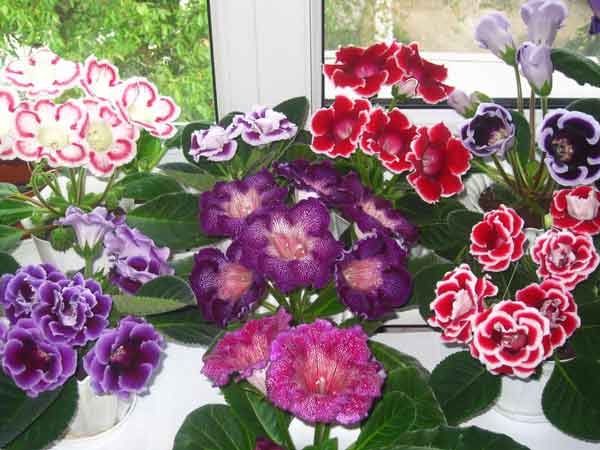
In the wild, there are more than 20 plant species, different varieties of hybrids have been bred from only two. Gloxinia the Beautiful has a tall stem with original leaves; a pattern of veins appears on them. Bells come in a variety of colors, from white to purple to purple.
On the shoots of a small bush of the Royal Gloxinia, there are leaves covered with silvery villi. On long peduncles, buds are formed, having blossomed, they reach 7 cm.
Breeding features
Gloxinia is suitable for vegetative reproduction, among other things, it is the simplest.
Using a leaf cutting (in two ways):
- Place the cutting in water and leave it there until the first roots appear. After that, plant in the ground for 5-7 days and cover with a jar.
- The scion can be placed directly into wet soil. After that, cover it with a jar or film for 2-3 weeks, keeping the temperature at 23 degrees.
Using the foliage plate:
- Take a healthy leaf.
- After that, make incisions on the convex veins in 2 or 3 parts and lay it on the soil, pressing a little.
- Expect small shoots to appear.
Varieties
Gloxinia Kaiser exists in two forms - Wilhelm and Friedrich.
Gloxinia Kaiser Wilhelm and Kaiser Friedrich are a very compact indoor culture, with beautiful, rich, deep shades of colors. The first has a dark purple color, or as it is also called "night" color, the second is painted in a delicate - crimson color. The feather and the second plant have a white border around the edges of the flowers, and the leaf plates are colored dark green with an emerald overflow.
Important! The flower of these varieties has one feature - they can hibernate, that is, be at rest for a certain time!
If you are interested in the varieties and types of gloxinia, then it will be useful to read the following articles telling about their diversity:
- Decorative Gloxinia Sonata.
- The most beautiful gloxinia Shagane.
- Hybrid gloxinia.
- Description of the varieties Krasnoyarye and Little Red Riding Hood.
- Lianas of climbing gloxinia.
- Brocada's charming gloxinia.
- Gloxinia Rosalind.
- White terry gloxinia.
- Gloxinia Pink.
Description of the species
In South America, this plant is found everywhere: on the rocks of Mexico, in the forests of Peru, along the slopes of the Andes. A visitor from the tropics also feels comfortable on the windowsills of Eurasia. The plant is unassuming to care for and is easy to propagate.
The variety of species is distinguished by the color of the inflorescences, their shape (bells or shoes), the number and arrangement of petals, and the size of the leaves.
Note! Flowers with petals arranged in several rows are especially attractive. This makes the double flowers look like a rose.
If we consider the species of gloxinia as a whole, we can distinguish common characteristics characteristic of all plants.
Features of gloxinia
| Sign | Description |
| Bush | Low - usually a little more than 10 cm (although in the wild it can reach 1.5 m). |
| Root | In true gloxinia, it looks like a carrot. Even in domestic plants, it is able to reach 0.4 m. In synningia, it is a fleshy tuber. |
| Leaves | Thick, green, sitting on a powerful handle. They can be shaggy and smooth, oval and oblong, with hairs or velvet-like down. In some varieties, the diameter is small - up to 1 cm, in others it reaches 0.2 m. They grow in groups of 3-4 pcs. or oppositely located. Form a ground-level low outlet. |
| Flowers | The most common form is an elongated gramophone * on a peduncle with a length of 1 to 15 cm. There are 5 stamens inside, each with 4 anthers. A straight ring-shaped pistil rises between them (it may be absent in hybrids). |
| Fetus | Small cone-shaped box (up to 1 cm).Inside contains seed - brown ellipsoids 1 mm long. |
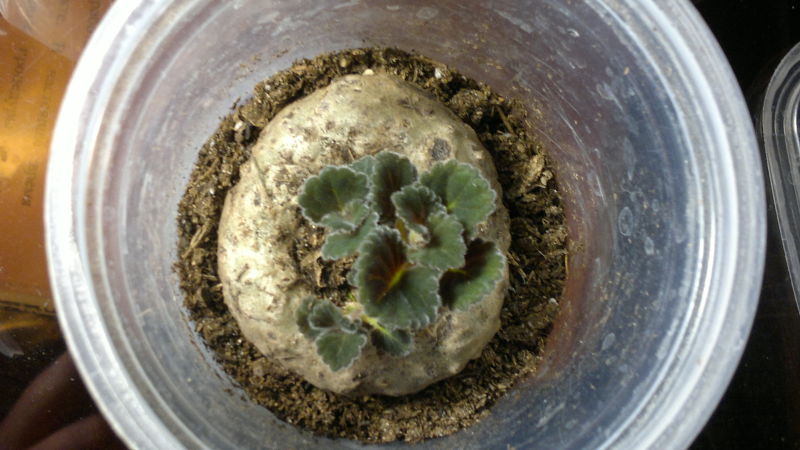
Sinningia tuber
Bushes come in a variety of sizes. It depends on the diameter of the foliage rosettes:
- less than 20 cm - miniature;
- 20-30 cm - semi-miniature;
- over 30 cm - standard.
All varieties of gloxinia are light-loving plants, but they can get burns from direct sunlight.
Note! A common feature of culture is seasonality. Even at home, gloxinia sleep in winter
Therefore, one should not be afraid that the ground part will die off by November. The tubers remain viable and, with proper care, will sprout in the spring.
general information
Gloxinia is an indoor flower. Otherwise it is called sinningia. It is a herbaceous perennial plant. It has rhizomes in the form of tubers, is a representative of the Gesneriaceae family.
The leaves are velvety, grow in breadth, and are moderately thick. A pleasant, delicate smell emanates from the leaves. Gloxinia has very beautiful flowers. Each flower looks like bells or shoes. They are located on peduncles of different lengths. Flowers differ in a wide range of shades. Coloring may vary.
For example, it can be white, pink, lilac, red, etc. Among all the variety of plants, there are simple varieties, terry. At the edges of the flowers, there is a border, a neat frill. The surface inside is strewn with specks of a darker or lighter color. The flowering period is usually in March and April.

In order for people to express their feelings, the language of flowers was invented in the eastern countries. The meaning of gloxinia is love that arises at first sight. Therefore, the plant is used as a kind of love talisman that brings peace and harmony to relationships.
The plant has an unusual ability. It helps in relieving fatigue, tension in a person who has been engaged in monotonous physical or mental work for a long time.
Its varieties are incredible in color. The catalog, which presents all the options, can be seen on the website of Svyatoslav Siletsky. He collected all the specimens, even the plants that breeders invented in 2015.
Botanical description and history of origin
The Gloxinia Kaiser bush reaches a height of up to 25 cm, so it will not take up much space. It also has repeated flowering, in which new buds appear instead of old ones. This cycle continues from spring to autumn. The open flower reaches from 7 to 8 cm in diameter, while up to 20 buds can bloom at the same time on one plant, and the inflorescence itself consists of five petals.
On small cuttings, leaf plates are attached, which have a slightly puffed surface, as well as wavy edges. Each of the leaves is large enough and reaches up to 20 cm in length. The leaves themselves are surrounded by large and beautiful flowers, which are located on relatively small peduncles. In general, the flower creates a wonderful decorative composition.
This plant was discovered and described in contrasting Latin America when a young amateur botanist Benjamin Gloxin participated in a marine expedition in the late 18th century. After that, the reproduction of this flower took place in greenhouses.
Common varieties
Knowing what gloxinia looks like, it is easier to choose a houseplant to decorate your home interior. Here you can sometimes get confused - such a variety of subspecies and varieties in terry specimens.
Gloxinia subspecies
| Name | Peculiarities |
| Gloxinia perennis | It translates as "year-round", because it has a small period of rest. You can recognize the variety by the leaf plates - they are reddish below. Fleshy shoots are speckled. Axillary flowers are collected on one peduncle. The bush reaches a height of 0.5-0.7 m. |
| Royal | Gloxinia is truly worthy of queens because of its beauty.It stands out for the velvety texture of dark green oval leaves, located in 4-6 pairs on a thick stem up to 10 cm high. Slightly drooping large bells with a diameter of 7 cm are painted in a dark purple hue. They are crowned with a long peduncle (about 20 cm). |
| Lovely gloxinia |
At first glance, it looks like a royal, but different: · A variety of color shades (purple, pink, blue, white, violet); · The shape of the flowers; · Lighter color of the plate. Leaves are broadly oval, with a dense short downy, located on long cuttings. If you look closely, you can see the original embossed pattern of veins. |
| Tiny | It stands out with small legs, each containing 1 flower. At the corollas, the curtain is short, two-colored - purple on top, white below. It fully justifies its name - the bush barely reaches 2.5 cm.Small and velvety oval-shaped leaves on the plant up to 1 cm long. |
Gloxinia royal
On the basis of subspecies, breeders create new beautiful varieties. The most popular among them:
- Yesenia is a delicate "rose" with a rich beet color;
- Winter cherry - her burgundy petals are speckled with white specks;
- Southern night - with small inflorescences of a black and burgundy hue;
- Tigrina mix - the variety got its name because of the unusual pattern on lilac, raspberry, lilac or white petals;
- Tiger Empress - large wine-red bells have wavy edges;
- Blue Gloxinia Avanti - petals, painted in all shades of blue, have a white border along the edge;
- Blue and white - it is distinguished by an original combination of colors: the white edging from the edge smoothly turns into a blue tint, which, in turn, turns into purple;
- Cleopatra is a wonderful representative of chintz coloring. White bells seem to be dusted with lilac and pinkish peas;
- Blanche de Meroux is characterized by a large velvety rosette, from which crimson open gramophones with a white core peep out;
- Blond Giselle is grace itself. On the pubescent stem, large bells bloom, dotted with purple or pinkish specks, there is a lilac tint in the necks;
Lady Jane's variety
- Madame Margaret - the crimson petals have wavy edges framed by a white narrow border;
- Kaiser Friedrich is characterized by a bright crimson color of the petals, framed by a wavy white border; the creamy neck is strewn with small specks;
- Gloxinia white - can be recognized by large snow-white petals with a greenish-purple throat;
- gloxinia Courage has large white gramophones diluted with pink specks;
- Merlin - it is difficult to see the true white shade of the petals behind the rich dark lilac speck;
- Lady Jane - dense small peas are scattered over the white flowers;
- Prins Albert - in the variety, a smooth transition of a blue-violet hue to a deep black visually turns the petals into a royal mantle;
- pink gloxinia The tale in the middle is colored with a crimson color, the lighter throat is strewn with dark specks;
- under the name Fusion Gloxinia, they mean hybrid varieties that stand out in a variety of shapes and colors.
The decisive color is for gloxinia. It is the bright shades that primarily attract lovers of unusual indoor plants. Based on this feature, it is possible to draw up a classification based on the hue.
Gloxinia varieties by color
| Shades | Names of varieties |
| Gloxinia terry white | Madonna, Article De Luxe, The Snow Queen, Fairy Wreath, High Light, Minx, Stephanie, Frosty Haze |
| Red gloxinia | Brocada, Estasi, Bohemia, Parisienne, Catarinka, Scarlett, Rua de Rouge, Etoile de Few, Queen of May |
| Gloxinia violet | Shagane, Starry night, Eliza, Shahinya, Madame Butterfly, Neptune, Light Violet Avant |
| Burgundy gloxinia | Kaiser Wilhelm (with a wide white border), Dream of Love, Hope, Parure |
| Black gloxinia | |
| Pink | Orlans, Masquerade, Pinik Flamingo, Rokoko Pink, Peach Rose, Dolce Vita, Triumph Tender |
Sinningia Conspicua
Gloxinia varieties
Sinningia varieties differ in characteristic features: plant height, bush splendor, rosette diameter, type of corolla.
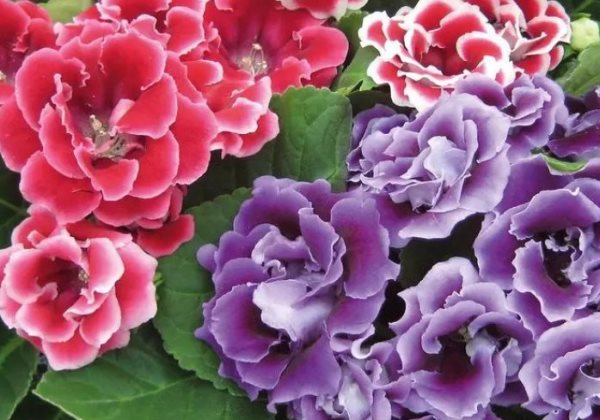
Corollas are simple, consisting of a single row of petals, and terry, multi-layered. There is also a difference in color: from pastel to the darkest tones, with specks and edging. The following are the main varieties and photos.
Gloxinia group of varieties Avanti avanti
Avanti are more commonly found as seed for individual cultivation. This group is characterized by a neat rosette, on its leaves velvety flowers look unusually impressive.
Gloxinia Yesenia
Terry hybrid from Holland has received mass cultivation around the world.
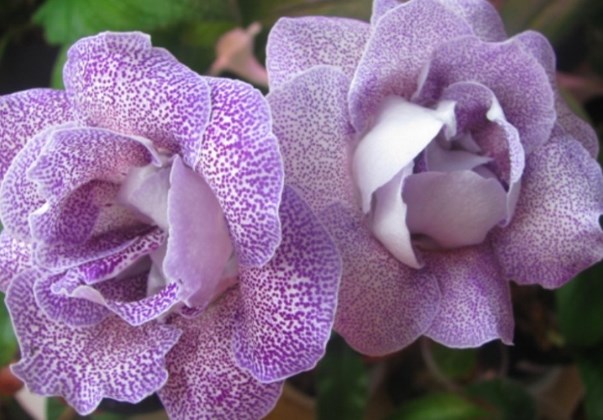
A voluminous plant up to 30 cm forms a green rosette and medium-sized cuttings, over which lush multi-layered flowers sway. The corollas are ajar, reminiscent of rosebuds, and when a bright scarlet or burgundy flower is fully revealed, a pinkish or snow-white border appears along the edge.
Gloxinia Hollywood
It is a very showy plant species, reminiscent of rich, bright purple velvet paper.
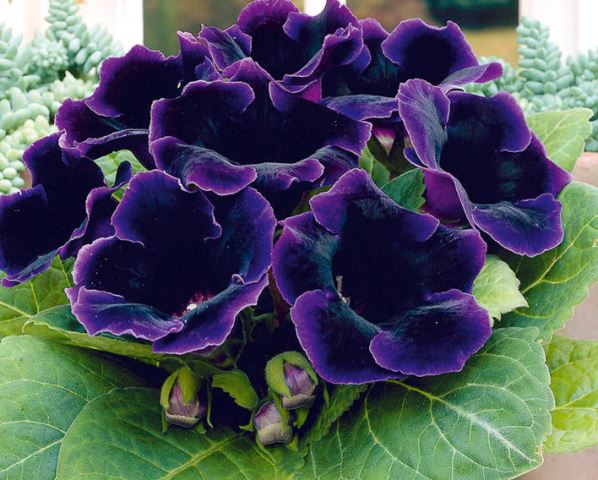
The petals are both dark and light. Inside, the flower is light lemon, with a bright purple speck. The hybrid blooms violently, the green mass of leaves is collected in a compact outlet.
Black Hollywood
It is characterized by deep purple, almost charcoal flowers without a colored center inside.
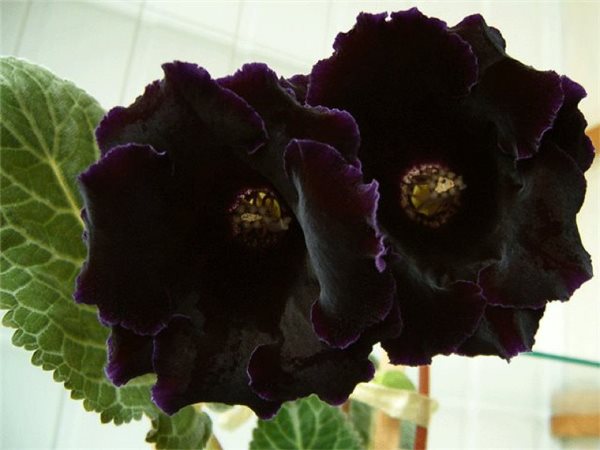
The flowering characteristics are similar to those of regular Hollywood.
Gloxinia Kaiser Wilhelm
The flowers are dark purple, simple in shape, decorated with a speckled center and bright white curling edges.

All this gives the plant a solemn, regal look and effectively distinguishes the variety from other subspecies.
Gloxinia Kaiser Friedrich
A bright crimson bell with a contrasting snow-white edging and a tiny light blotch in the neck of the flower gives off a regal person of the Kaiser Friedrich variety.
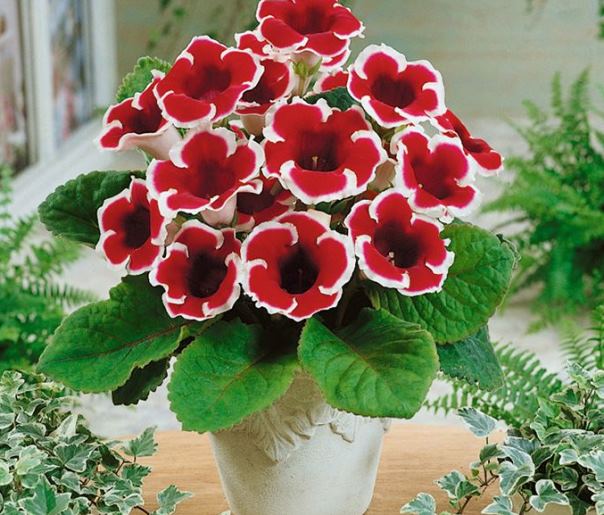
The petals are formed by a flounce, and the outside is dazzling white.
Bright purple, sometimes almost black corollas are gracefully wrapped in a voluminous shuttlecock. A dense color goes along the entire length of the corolla; a light contrasting spot is interspersed in the lower part. The green rosette throws out medium stalks.
Gloxinia Blanche de Meroux
Gloxinias Blanche de Meru have 5 lily-white petals. Looks smart, elegant.
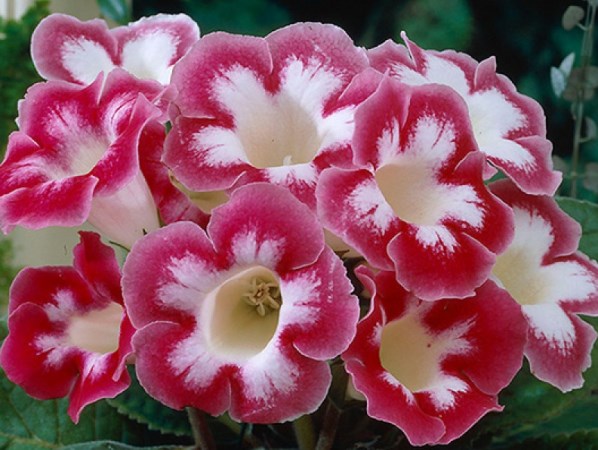
The green leaves resemble velvet. The variety is not very whimsical, it tolerates some errors in care.
Gloxinia Violacea
A classic flower with a simple shape. Purple inflorescences with a white neck covered with lilac blotches, and wavy edges of the petals.
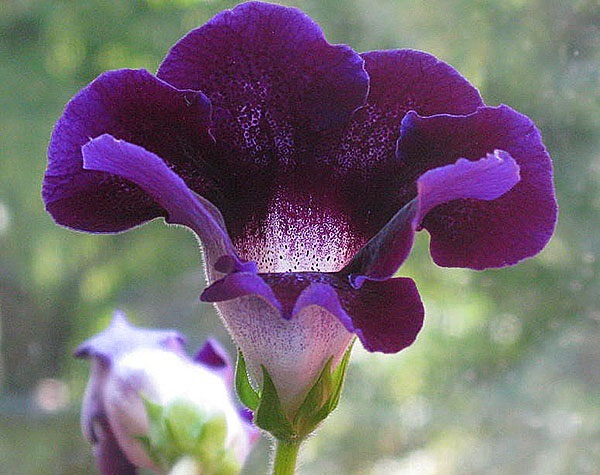
The flower stalks are tall, so a plant in full bloom needs support. Long-term bloom, from June to August.
Gloxinia Shagane
This terry variety with voluminous bell-shaped flowers is very beautiful, it immediately won the hearts of many amateur flower growers.

A very interesting purple Tigrina with a greenish neck and a bright purple border. The original inserts in the form of boiled white petals distinguish it favorably from other varieties. There are purple blotches on the light part.
Gloxinia the Snow Queen
Another unusual variety. The corolla looks like a royal goblet of pale lilac color, the depth is dark purple.
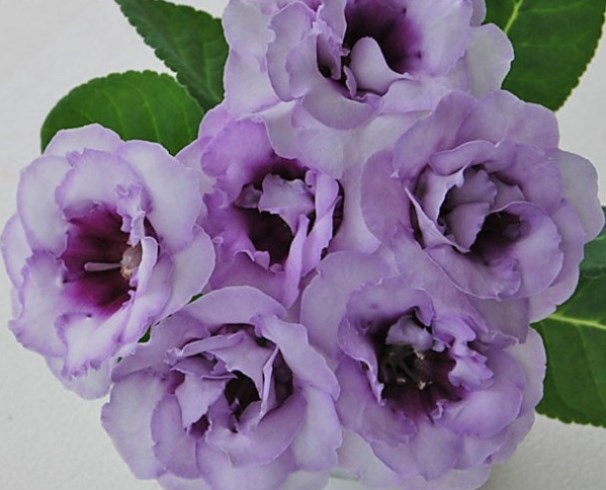
Lush airy petals are gathered in a weightless shuttlecock.
Terry splendor
Gloxinia Zaznoba looks very attractive. Its double flowers are large in diameter, white in color. The petals are covered with purple-purple dots, there is a lilac border with a purple tint. The variety is characterized by the compactness of the bushes.
Gloxinia Moon Shade belongs to the terry variety, endowed with huge flowers. There is a wide purple frame on the petals, white blotches give the flower unusual and tenderness.Among connoisseurs and professionals, the variety is recognized as a masterpiece.
Gloxinia Winter Cherry is similar in appearance to the previous variety, but its petals are adorned with small peas that play burgundy and purple. The bushes look very beautiful in pots on the windowsills, the decorative effect is emphasized by a compact neat bush with short peduncles.
Gloxinia Cleopatra is a terry variety. An inexperienced person will not immediately be able to distinguish it from Winter Cherry varietiesthat is due to external identity.
One of the most beautiful varieties of the terry variety is the Milky Way variety. It immediately amazes with its luxury, singularity and grandeur. The diameter of the flowers is very large. There are specks (purple, lilac) on the white petals, while the colors are less bright at the edges, which adds sophistication. The leaves are endowed with a vein of a silvery hue, the very base of the leaf is light green. The peduncles of this variety are of medium length, but this does not diminish the visual appeal.
Varieties with unusual or solemn names are especially popular. For example, Gloxinia Calico Wedding. It can be presented to spouses as a symbolic anniversary gift. On a white background of petals, there is a lilac speck. On the edges there is a thin rim (there is a very dense speck, the color is lilac). Terry Sudarushka is distinguished by romance and playfulness. Medium-sized peas are clearly visible on the white petals. Their color is red with a pink tint. Sudarushka has strong peduncles, compact bushes.
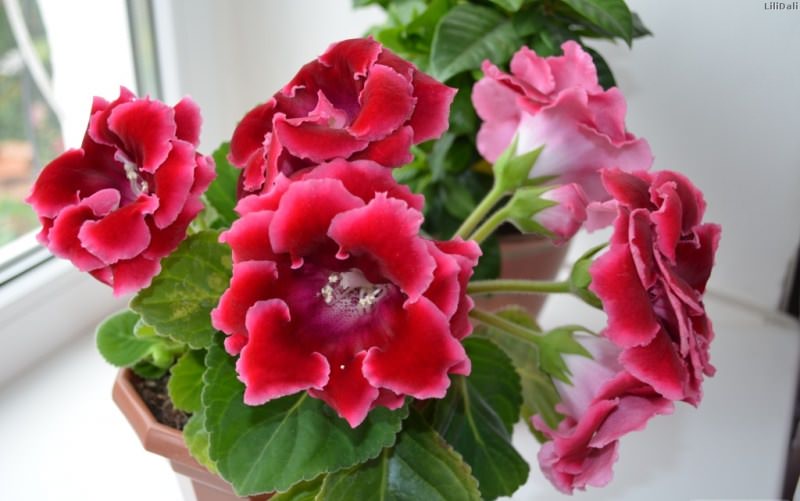
The Pani Valevskaya variety is distinguished by its extraordinary decorativeness. The main color of the flowers is white, they are terry. The border stands out clearly against the white background, as it is itself crimson-red. On compact bushes there are small in length but strong peduncles.
Gloxinia Crimson Etude has a red border around the edges. On the petals, you can see not only dark red peas, but also strokes, which adds exoticism. Peduncles of this variety are long.
Gloxinia Charm captivates with the contrast of a delicate terry white base and a rich pink frame around the edges. Bright pink polka dots are randomly placed throughout the flower. Peduncles are of medium length and special strength, the bushes are neat, compact.
Features of reproduction and cultivation
Gloxinia is transplanted in the spring after the flower is well rested
The tubers are carefully removed from the pot, washed and dried from moisture
They are not completely covered with new earth, which makes it possible for the leaves to come out faster. Watering is unnecessary three days after planting.
The flower is propagated:
- seeds;
- cuttings;
- dividing the tuber.
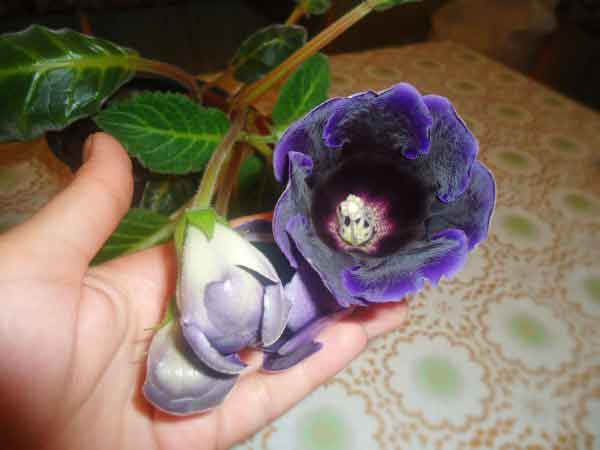
The leaf of the plant is cut and buried 5 ml into the ground without petioles, covered with polyethylene and placed in a warm place. The sprouts that appear are moved to the pot.
Gloxinia seeds, which are sold at a flower shop, are spread on the ground, which must not be forgotten to spray. Glass is placed on top of the container. The first shoots will delight in 15 days. The seedlings dive and are planted in pots. Read more about how to breed gloxinia from seeds here.
It is not difficult to propagate gloxinia by dividing the tubers with sprouts. The cut on each of them is sprinkled with ash, the roots are sent to separate containers.
Astrologers attribute gloxinia to the constellation Taurus. This zodiac sign has clean energy, which has a positive effect on a person's condition. The bright flowers of the plant soothe, improve mood.

Similar flowers
- Violet - the plant belongs to the violet family. It grows mainly in regions with a temperate climate. Terry gloxinia is a beautiful houseplant that attracts with large flowers. There are about 70 species of this plant.
- Gloxinia Avante white - belongs to the section terry. It resembles a camellia or a garden rose in shape.
- Gloxinia Yesenia is a terry Dutch hybrid.Reaches 30 cm in height and is the cultivated plant in the world.
- Gloxinia Prince Albert is a simple gloxinia cultivar with effective flowers. Has extra grace in the form of wavy edges.
Gloxinia is undeniably a beautiful flower. Growing it isn't as easy as we'd like it to be, but it's worth it. Not a single guest will pass by without making a single compliment to such beauty!
Interesting options
Gloxinia Madonna is popular for its color. For the flowers of the Madonna, a certain lacy airiness is inherent, they are white, and their middle is yellow or even lemon. There is a fringe on the petals, which visually makes the volume of the flower even larger. The stalk on which the inflorescences are located. high enough, large leaves are placed on it, the color of which is presented in light green tones. Florists note that Madonna is easy enough to propagate, and she is well accepted.
Gloxinia terry white has rather large flowers, the neck of which is colored green and lemon. The leaves are green with an emerald tint, the stem is characterized by high strength, but it is not very tall. The bushes are distinguished by a high level of compactness.
Peach rose - terry gloxinia, which is painted in delicate shades of pink. In the central part of the petal, there is a rather wide, but blurred stripe. Its color is dark pink, but there are varieties with a softer palette in the center. Small white dots can be seen in the throat of the flower. The stem on which the flowers are located is low. Sometimes flowers are found, painted white, and their central part is pink.
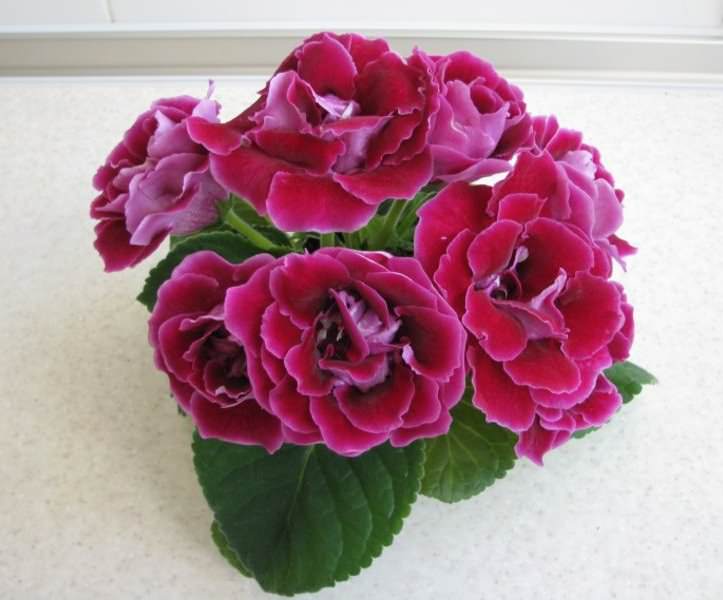
The Snow Queen is a representative of terry gloxinia. Its flowers are quite large. The middle of the flower is purple and the rest of the petal is white. Although flower growers have options with a lilac color, which can be obtained through certain plant care technologies. The edges of the petals of such a plant are framed with a lilac line. The bushes are compact.
Gloxinia Constellation of Love is a bright double flower bordered with a burgundy edge. The throat is colored in light, practical white tones. The petals are not very large, the stems are strong. Unpretentious in care.
Some important subtleties
Since the homeland of gloxinia is warm South America, this plant requires a little more attention than any other home flower familiar to our climate. Although numerous hybrid indoor varieties are still less whimsical and capricious. It should also be remembered that this plant is seasonal, and do not be afraid if, after the end of flowering, your newcomer suddenly drops the foliage and withers away. You just need to keep the dormant tuber until spring, and again wait for the appearance of bright buds and juicy greenery.
If you decide to give the interior of your home or office a multicolored decoration pleasing to the eye, then the compact and very impressive indoor gloxinia will be a very good choice. In addition to aesthetic splendor, they are able to fill the room with an exquisite, pleasant aroma.
Where and how to plant
Hybrids obtained by breeding from tropical dwarf shrubs are quite finicky. They will not release buds if there is little light, the earth is not good, the humidity is not satisfied. Home care for gloxinia requires special attention to precisely these points.
Important! Direct rays of the sun have a negative effect on hybrid varieties of gloxinia, but with a lack of light, the leaves stretch out. In winter and autumn, when the day is shorter than 12 hours, you additionally need to turn on the lamp .. Stir the plant on a spacious window - west or east
It does not tolerate drafts, therefore, during airing, the flower pot must be rearranged to another place.
Stir the plant on a spacious window - west or east. It does not tolerate drafts, therefore, during airing, the flower pot must be rearranged to another place.
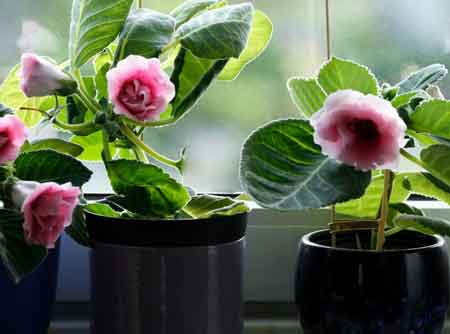 The flower loves moisture, but the leaves suffer from water, it is better to pour it into a tray.
The flower loves moisture, but the leaves suffer from water, it is better to pour it into a tray.
During the flowering of gloxinia, it is better to keep the temperature in the room at a level of 20-22 degrees, when it is resting - 10 is enough.
If the plant is hot, the leaves rise, drop when it's cold.
For gloxinia to be dotted with buds, the soil must be:
- easy;
- breathable;
- loose.
Such indicators are provided by leafy soil, peat, sand and turf. Expanded clay or pebbles are laid at the bottom of the tank, which guarantees good drainage. Before planting a tuber to kill fungi and bacteria, the soil is calcined in the oven or steamed.
A plastic or clay pot with a tuber is placed in a larger container. An indoor flower is transplanted at the end of winter, fresh soil is used each time. Gloxinia feels good near an aquarium, a fountain, where the humidity reaches 70%.
The most common types
Gloxinia Royal is one of the most popular and frequently encountered representatives. Its peculiarity is a low height (up to 10 cm), but the plant has strong shoots. About 12 leaves are placed on them, and they usually stand in pairs. The leaves themselves are quite large and can reach 20 cm in length. They have an interesting shape, reminiscent of an oval. They are also characterized by a specific color of green. The flowers have a dark purple color, they are quite large, since their diameter is on average 7 cm. They are pleasing to the eye in summer.
The beauty of gloxinia in its appearance resembles the Royal. The leaves of the plant have a slightly different color, since their shade is somewhat lighter. In addition, there are no silvery veins on its leaves. The beauty of gloxinia has large flowers. They are most often purple, and purple-colored variants can also be found.

Yesenia is popular with flower growers due to the fact that her flowers are terry, which looks very attractive from the outside. Their color is usually burgundy or beetroot. The flowers on the bush are abundantly placed, and the bush itself is characterized by compactness. The leaves look like velvet on the outside.

